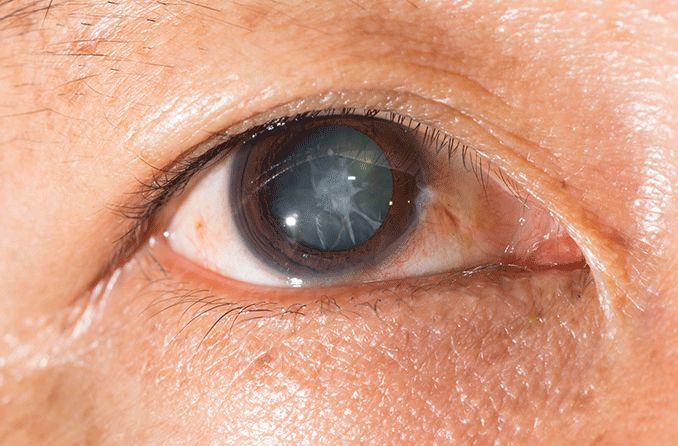Traumatic cataracts: Causes, symptoms and treatment

A traumatic cataract is a clouding of the eye’s natural lens after an injury. This is usually due to blunt or penetrating trauma to the eye from an accident or violent attack. More rarely, a traumatic cataract can develop as a result of electric shock, chemical burns or radiation.
A traumatic cataract may develop within weeks of an injury to the lens, or it can take months or even years. That’s why regular follow-up care with your doctor is important.
A quick look at eye injuries
Eye injuries are common, with up to one-fifth of adults having an eye injury at some point in their lives. Each year, more than 55 million eye injuries are serious enough to restrict activities for at least a day, and nearly 750,000 eye injuries require hospitalization.
An eye injury is classified by its cause:
Blunt trauma – The most common cause of eye injury, this occurs when the eye is hit by a fist, ball, or other blunt object, without actually cutting the eye.
Penetrating trauma – This occurs when the eye is actually pierced (penetrated), perhaps by a knife, sharp stick or piece of metal.
Radiation exposure – Eye injury can occur after excess sun exposure (ultraviolet radiation) or exposure through work (such as an X-ray technician or welder) or medical treatment (such as a cancer patient receiving radiation therapy).
Chemical exposure – This type of injury happens when chemicals enter the eye, usually in an accident, and damage the lens.
Eye injuries that can result in a traumatic cataract are often due to accidents, including:
Eye injuries occurring in sports such as ice hockey, softball, tennis and baseball
Car accidents
Work-related injuries, especially in jobs that require hammering, electrical work or drilling
Tripping and falling, where something pierces the eye such as a wooden stick or thorn
Firecrackers exploding too close to the face
BBs from BB guns firing into the eye
An eye injury can also be the result of a violent attack.
What are the symptoms of a traumatic cataract?
When the eye has been injured and develops a cataract, symptoms can include:
A misshapen eye
Eye pain
Bleeding
Swelling
Inability to see well or to see at all
If the lens is swollen, it can cause the pressure in the eye to rise, but if the eye is very damaged, the intraocular pressure may fall.
What does a traumatic cataract look like?
A cataract due to blunt trauma often looks like a white rosette of petals or feathers. A cataract due to a piercing injury may be smaller but it may also expand rapidly. This rosette can appear right after the injury, or months to years later. In nearly half of traumatic cataract cases, the back of the eye is injured as well.
How is a traumatic cataract treated?
A traumatic cataract is treated like any other cataract. If it is small, stable or outside the main line of vision, it may be observed by the doctor through follow-up visits. If it is close to the center of vision, eye drops to enlarge the pupil may help improve vision. Occasionally a mild traumatic cataract will heal on its own, especially in children.
If the cataract must be removed, the clouded lens will be extracted surgically and replaced with a clear artificial lens.
Usually a new, artificial lens is implanted at the same time the cataract is removed. However, if an eye injury is extensive, a surgeon may choose to wait until the eye has healed before implanting an artificial lens. Waiting may also make it easier to determine the correct focusing power for the new lens.
If there are other eye injuries that can be treated at the same time, the eye surgeon will repair those as well. If the other eye injuries are severe, they will be treated first, and the cataract will be removed after the eye has healed.
How can I avoid a traumatic cataract?
The best way to avoid a traumatic cataract is by protecting your eyes, especially when playing sports and working around dust and debris. You should always wear protective eye goggles or glasses if you think your eyes might be at risk of an injury.
What causes cataracts? Medical Eye Center. December 2018.
Eye trauma. The University of Illinois College of Medicine. Accessed September 2021.
Management of traumatic cataract. American Academy of Ophthalmology. August 2016.
The global impact of eye injuries. Ophthalmic Epidemiology. September 1998.
Traumatic cataract. Dr. Agarwal’s Eye Hospital. Accessed September 2021.
Blunt eye trauma. VisionCenter. July 2021.
Traumatic cataract: What, when, how. Graefe's Archive for Clinical and Experimental Ophthalmology. April 2010.
Traumatic cataract. Medscape. September 2018.
Traumatic cataracts/rosette cataracts. Optometry Students. December 2011.
Traumatic cataract treatment and management. Medscape. September 2018.
Spontaneous resolution of a traumatic cataract in a patient with an open-globe ocular injury: a case report. BMC Ophthalmology. July 2020.
How to manage the complications of a traumatic cataract. Healio. October 2009.
Page published on Wednesday, October 13, 2021
Medically reviewed on Friday, September 17, 2021





